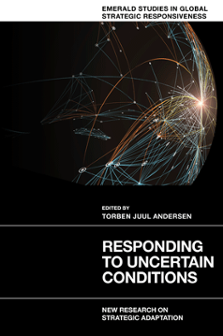
Index
Responding to Uncertain Conditions: New Research on Strategic Adaptation
ISBN: 978-1-80455-965-9, eISBN: 978-1-80455-964-2
Publication date: 14 March 2023
Citation
(2023), "Index", Andersen, T.J. (Ed.) Responding to Uncertain Conditions: New Research on Strategic Adaptation (Emerald Studies in Global Strategic Responsiveness), Emerald Publishing Limited, Leeds, pp. 217-222. https://doi.org/10.1108/978-1-80455-964-220231011
Publisher
:Emerald Publishing Limited
Copyright © 2023 Torben Juul Andersen
INDEX
- Prelims
- Chapter 1: Strategic Flexibility
- Chapter 2: Adaptive Strategy-making and Left-skewed Performance Outcomes
- Chapter 3: Behind the Scenes of Strategy: Middle-management Tactics for Shaping Digital Transformation
- Chapter 4: Responding to Advance Upside Potential Through Interactive Strategic Control Processes
- Chapter 5: Employee Health for Strategic Adaptation: The Role of Enabling and Constraining Performance Measurement
- Chapter 6: Beyond Management Control: A Nexus of Relational Practices as Enablers and Boundaries for Strategizing in the Face of Uncertainty
- Chapter 7: Beyond Compliance: An Event History Analysis of Environmental Stewardship
- Chapter 8: Crises and Resource Scarcity and Adaptability: Toward a Multi-level Bricolage
- Chapter 9: The Influence of Organizational Justice on Firm Performance: A Stakeholder Management Perspective
- Chapter 10: A Contemporary Review of the Resilience Literature: State-of-the-Art and Future Research Opportunities
- Index